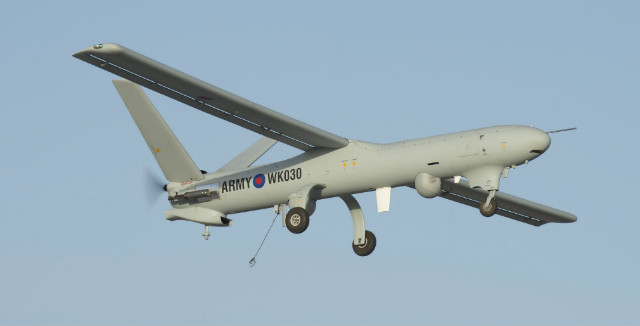A leading figure in the British Army’s unmanned air vehicles operations has praised the first deployment of the force’s new Elbit Systems/Thales WK450 Watchkeeper system, during which it was involved in three-way UAV operations to offer cueing and intelligence to the US Marine Corps in Afghanistan.
One system consisting of four aircraft was deployed to theatre in August and was used to provide wide-area surveillance to British troops that were in the process of withdrawing from Camp Bastion, Lt Col Craig Palmer, commanding officer, UAS branch leader, 32nd Regiment Royal Artillery, told the SMi Unmanned Aerial Systems conference in London.
The first in-theatre flight took place on 2 September, followed by the first operational flight on 16 September. During the latter, Watchkeeper provided wide-area surveillance for the USMC using its Thales I-Master radar, which then cued the army’s leased Elbit Systems Hermes 450 – on which the Watchkeeper airframe is based – to continue maintaining the surveillance track.
This information was then passed on so that the Royal Air Force’s General Atomics MQ-9 Reaper UAV could carry out a strike on the particular target.
“The US Marine Corps were pretty delighted with that,” Palmer says.

Crown Copyright
Some 140 flight hours of a part-Watchkeeper capability were flown until operations ceased in mid-October, he adds.
“Previously, we had lots of classic ‘soda straw’ [capabilities], but these needed to be coordinated…better as we drew down,” Palmer says. “When you do a transition operation, you are vulnerable.”
Watchkeeper flew about eight hours a day, which Palmer says was enough to cover the transition period as the UK withdrew from Bastion.
“Watchkeeper – while still in its first version – is an excellent air system,” Palmer adds. “But we believe we’ve only just scratched the surface.”
Palmer says the I-Master’s capabilities, including dual-mode synthetic aperture radar and ground moving target indication, were the main reason for deploying the UAV so late in the conflict: “We believe this is an awful lot of bang for your buck on this size of aircraft.”
Dust clouds are one of the main hindrances to Hermes 450 operations because it has only an electro-optical/infrared payload, although the vehicle “was an excellent foundation for our growth,” Palmer says.
“Dust clouds in Afghanistan energise the Taliban,” Palmer explains. “So we need to own the day, the night and the dust. The radar is very important. … We need to deny the dust to the Taliban.
“The radar is the game-changer.”
Full operational capability (FOC) is expected to be achieved for Watchkeeper in 2017, when de-icing and rough strip capabilities, among others, will be added to the system. There will be another release to service (RTS) – similar to the initial operational capability RTS that was awarded earlier this year – granted when it reaches FOC.
Now that the deployed systems have returned to the UK, training will continue at Boscombe Down in Wiltshire. The contract covers the delivery of 54 aircraft, although they have not all been delivered to the army as of yet – something which Palmer claims will ease the maintenance burden to the army that operating extra aircraft would add.
Meanwhile the army stopped using the interim-operated Hermes 450 – and the lease contract in turn ended – when the ground-based radar coverage at Bastion was switched off ahead of the British withdrawal, Palmer confirms.
“We’re now into the Watchkeeper era,” he says.
Source: FlightGlobal.com


























